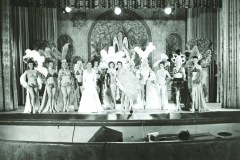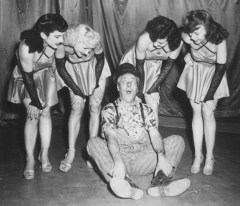When Leslie Zemeckis began working on her documentary Behind the Burly Q, she knew little of the famed performers that dominated the old-time burlesque scene. By the time the film was released in 2010, she had more information on the little-understood art form than she knew what to do with. Her solution: write a book—with the same title as her movie—that would present all this newfound knowledge.
The hefty book—now in bookstores—allows Zemeckis to go beyond the first-person accounts of the movie and get into the social history that led burlesque to evolve from a satirical theatrical format into the kind of activity that many modern culture-lovers think belongs in a strip club. (The women who knew otherwise didn’t speak up for a long time, often due to the stigma associated with burlesque.) Here—from the information we picked up from the book and an interview with Zemeckis—are are seven facts that take you behind the fan dance.
Burlesque didn’t start out as a strip show
The original meaning of the verb “to burlesque” was “to make fun of.” In 19th-century Europe, burlesques were satires about popular “legit” plays, offering ordinary folks a chance to mock the tastes of the upper classes and comment about how sex jokes knew no class boundaries. Though some think the format goes back Roman times, one of the most important early burlesques cited by Zemeckis was an 1869 show that combined the British Blondes, a troupe of scantily-clad chorus girls from across the pond, performing in American minstrel/variety traditions. Stripping wasn’t a part of burlesque for about another 50 years after that.
(PHOTOS: Gypsy Rose Lee: LIFE with a Burlesque Legend)
Burlesque has its own lingo
Burlesque stars were known for their colorful pseudonyms (the legendary performer known as Blaze Starr wrote the forward to Behind the Burly Q), but the fun language didn’t stop there. The circuit of towns the burlesque shows traveled was known as “the wheel”; the man who sang during a chorus number was the “tit singer.” (Fun fact: the actor Alan Alda’s father, Robert Alda, was a tit singer.)
The burlesque dancers were in it to survive
Unlike many of the women (and men) who are involved in today’s feminist-friendly neo-burlesque scene, in which empowerment and controlling your own body are central tenets, the dancers who pioneered the format were in it for different reasons. “I get that all the time—were these the early feminists? No, they were really surviving,” says Zemeckis. “I don’t think they felt empowered. They were working and doing a job. Some of them loved what they did and put a lot of effort into it, and a lot of artistry, but I don’t think they thought they were the forerunners of independence. They had no choice, a lot of them, coming from hard economic times and abusive situations. [Burlesque] was what they could do.”
There was a correlation between societal mores and how much skin was shown…but that wasn’t the only factor
The march toward nudity has driven the development of burlesque from vaudeville to strip clubs, but that progress has not always been driven by looser social norms. One of the driving motivations was the introduction of new media and entertainment: whether they were competing with radio or Playboy or even the advent of the bikini bathing suit, burlesque performers were able to keep their audiences by losing their clothes. In addition, when local authorities (like New York City’s municipal government) cracked down on obscenity in the 1930s, burlesque operators had to ditch the stripping or risk losing the family audiences that had long been part of the tradition. (Yes, it was once considered wholesome entertainment!) The went for the former. With kids no longer in attendance and shows moving to more open-minded locales, stripping became more central. Eventually, however, that would lead to the end of burlesque: porn theaters and strip clubs replaced the art starting in the 1960s.
(VIDEO: Burlesque and Breast-Cancer Survivors)
Comedians were originally the stars of burlesque
“Comedians started out as the kings,” says Zemeckis, who says many people have the mistaken idea that burlesque comedians were funnymen who couldn’t get work elsewhere. “A lot of great talent came from there and they’d all say it was a training ground.” However, few young comedians filtered into the burlesque world as the older ones aged and, with TV as another option for comedians and stripping moving the dancers to the top of the burlesque totem pole, comedy faded in importance. Zemeckis also thinks that the low-brow comedy that could appeal to anyone—pretty girl walks by and comedian’s tie stands up, to take an example—is a little unsophisticated for today’s audiences, who have “outgrown” simple jokes and the thrill of a peek of flesh.
Burlesque was big business
What was most surprising to Zemeckis in the course of her research was the size and scope of the burlesque industry. “I didn’t know that thousands of people worked in it, that the shows were packed. I didn’t know there were huge orchestras,” she says. “I thought it was like a little show. I didn’t realize there were so many people involved.” At its heyday, burlesque was much bigger than Broadway.
The first strip in burlesque was maybe an accident
Zemeckis writes about many theories that trace the origins of stripping. Was it around 1904, when Millie DeLeon removed her garter? Was it in 1917 when a performer began taking off her costume just before she got off stage? Was it in 1925 when a performer removed a costume item, a cuff, she noticed had gotten dirty? Was it an accident, caused by a broken strap? The world may never know.
(MORE: New Burlesque Strips Down)



